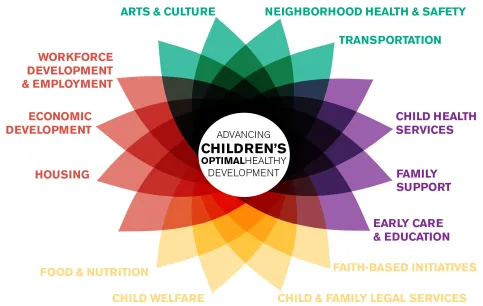“It’s all about the system,” said Paul Dworkin, MD, executive vice president for community child health at Connecticut Children’s. “If we are going to be successful in supporting families in ensuring their children’s health and development, we must engage all of the sectors that are so critically important to family support.”
The diagram’s foundation lies in the purple petals: child health services, family support, and early care and education. Those three areas encompass a traditional approach to child development.
However, we quickly realized that advancing optimal health, development and well-being entails much more. So, the flower diagram bloomed to include all of the other categories: faith-based initiatives, child & family legal services, child welfare, food & nutrition, housing, economic development, workforce development & employment, arts & culture, neighborhood health & safety, and transportation.
“We are continually emphasizing the importance of different agencies working together, blending administrative and financial resources to achieve common goals,” said Dr. Dworkin. “We are also emphasizing the importance of not exclusively focusing on children with the most complex of medical conditions but expanding that focus to also include all children and families, especially those who are vulnerable and at risk. Also of importance is the recognition that this type of work does yield rewards, including financial benefits. There is a return on investment but that return takes years and years to accrue.”
Without this comprehensive approach to promoting optimal health, development, and well-being, children would find themselves at an even greater risk for exposure to toxic stress, developmental delays, or behavioral problems, all of which the Office is working to address. In fact, we believe children are even at greater risk if just one petal falls off of their particular flower.
You’ll notice the diagram also includes blank petals. That’s because we realize there are other areas affecting child health that we have not yet identified. Our diagram, just like the children it is designed to serve, is constantly evolving as we strive to strengthen families and communities to promote the optimal health, development and well-being of children.

